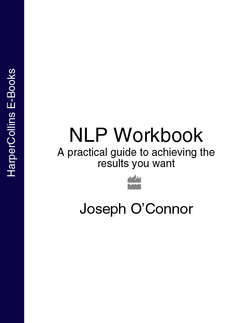NLP Workbook: A practical guide to achieving the results you want

Реклама. ООО «ЛитРес», ИНН: 7719571260.
Оглавление
Joseph O’Connor. NLP Workbook: A practical guide to achieving the results you want
CONTENTS
ACKNOWLEDGEMENTS
INTRODUCTION
How to Use This Book
CHAPTER 1. WHAT IS NLP?
Internal Ecology
External Ecology
ACTION PLAN
CHAPTER 2. OUTCOMES
Beliefs and Outcomes
Possibility
Ability
Worthiness
Affirmations
ACTION PLAN
CHAPTER 3. LEARNING
The Learning Zone
Simple and Generative Learning. Simple Learning
Generative Learning
The Language of Neurological Levels
Neurological Level Alignment
The Meta Mirror
The Effective Meeting Pattern
ACTION PLAN
CHAPTER 4. RELATIONSHIP
Pacing Yourself
The Environment
Behaviour
Capabilities
Beliefs and Values
Identity
Beyond Identity
ACTION PLAN
CHAPTER 5. THE SENSES
External Attention
Internal Attention
The Kinesthetic System
The Visual System
The Auditory System
The Olfactory System
The Gustatory System
Eye Accessing Cues
Other Eye Patterns
Questions for Accessing Cues
Seeing Mental Pictures
Hearing Mental Sounds
Getting in Touch with Feelings
Lead Representational System
Translation
Overlapping
Part One
Part Two
Visual Predicates and Phrases
Auditory Predicates and Phrases
Kinesthetic Predicates and Phrases
Olfactory Predicates and Phrases
Gustatory Predicates and Phrases
Non Sensory-Specific Words and Phrases
Examples of Unspecified Words
Future Pacing Organizational Change
Mental Rehearsal Principles
ACTION PLAN
CHAPTER 6. EMOTIONAL STATE
Your Baseline State
Setting Anchors
Eliciting a Resource State
State Elicitation: Mental
State Elicitation: Physical
Calibrating the State
Anchor the State
Test the Anchor
Future Pace
Chaining Anchors
Stacking Anchors
Collapsing Anchors
Collapsing Anchors Pattern
Chaining Anchors
States and Meta States
Changing States: Summary
ACTION PLAN
CHAPTER 7. INSIDE THE MIND
Digital and Analogue Submodalities
Visual Submodalities
Auditory Submodalities
Kinesthetic Submodalities
Olfactory and Gustatory Submodalities
Critical Submodalities
Language and Submodalities
How to Elicit Submodalities
Tonality
Trouble Shooting
Learning from Experience
Part One
Part Two
Part Three
The Fast Phobia/Trauma Process
Eliciting a Time Line
In Time and Through Time
Using Time Lines
Laying Out a Time Line
ACTION PLAN
CHAPTER 8. STRATEGIES
The NLP TOTE
Strategy Notation
Summary
Other Symbols
Installing Strategies
Disney Creativity Strategy
New Behaviour Generator
ACTION PLAN
CHAPTER 9. LANGUAGE
Language as a Representational System
Deleion
Generalization
Distortion
Deep Structure and Surface Structure
Questions and Transderivational Search
What Can Questions Do?
Questions about Questions
CHAPTER 10. THE META MODEL
Deletions
Generalizations
Distortions
What Does the Meta Model Do?
Meta Model Patterns: Deletions
Meta Model Patterns: Comparisons
Meta Model Patterns: Judgements
Meta Model Patterns: Universals
Meta Model Patterns: Modal Operators
Modal Operators of Possibility
Modal Operators of Necessity
Meta Model Patterns: Nominalizations
Meta Model Patterns: Mind Reading
Meta Model Patterns: Complex Equivalents
Meta Model Patterns: Cause–Effect
Reverse Cause–Effect
Meta Model Patterns: Presuppositions
Deletions. Simple Deletion
Unspecified Referential Index
Unspecified Verb
Comparison
Judgement
Generalizations. Universals
Modal Operators of Necessity
Modal Operators of Possibility
Distortions. Complex Equivalents
Nominalization
Mind Reading
Cause–Effect
Presupposition
ACTION PLAN
CHAPTER 11. THE MILTON MODEL
Trance
Trance Indications
Everyday Trance
Milton Erickson
The Milton Model and the Meta Model
Milton Model Patterns
Deletions
Distortions
Generalizations
Pacing a Person’s Experience…
Distracting the Conscious Mind
Accessing Unconscious Resources
Politics, Sales and Advertising
ACTION PLAN
CHAPTER 12. METAPHOR
Everyday Metaphors
Types of Metaphor
Isometric Metaphors
Two Stories
ACTION PLAN
CHAPTER 13. WRITING
Clear Writing
The Fog Index
Digital Language
The Meta Semantic Generator (MSG)
Sensory Language
ACTION PLAN
CHAPTER 14. UNDERSTANDING
Chunking Up
Chunking Down
Chunking Sideways
Chunking Language
Before the Negotiation
During the Negotiation
After the Negotiation
Negotiation Skills
Backtracking
Aligning Perceptual Positions
Incongruence Signal
ACTION PLAN
CHAPTER 15. FRAMING
The Ecology Frame
The Outcome Frame
The Backtrack Frame
The Contrast Frame
The ‘As If’ Frame
The Systemic Frame
The Negotiation Frame
Outcomes rather than Blame
‘How’ rather than ‘Why’
Possibilities rather than Necessities
Feedback rather than Failure
Curiosity rather than Assumptions
Context Reframing
Content Reframing
Reframing Beliefs
Reframing Structure
Six-Step Reframing
Six Steps
ACTION PLAN
CHAPTER 16. PUTTING IT ALL TOGETHER
First Order Change
Second Order Change
The Principal Elements of NLP
Leverage Pattern: Language, Physiology, Thinking
1. Your State
2. Rapport
3. Gather Information
4. Outcome
5. Resources
6. Utilize Resources
7. Test
8. Future Pace
Resources
Applying the Patterns
Generative Problems – Making Things Even Better
The 80:20 Rule
How to Get the Most from NLP
ACTION PLAN
APPENDIX 1. NLP PATTERNS
Language
Thinking
Physiology
APPENDIX 2. THE PRINCIPAL INFLUENCES ON NLP DEVELOPMENT
Reference
Reference
References
Reference
References
References
Reference
Reference
Reference
References
BIBLIOGRAPHY
General and Introductory
Business
Education
Training
Health
Sports
Sales
Therapy
Background Reading
GLOSSARY
NLP RESOURCES
Internet Resources
LAMBENT DO BRASIL
International Coaching Certification
International Coaching Community (ICC)
International Community of NLP (ICNLP)
Training Courses
Distance Learning
INDEX
If you enjoyed NLP Workbook: A practical guide to achieving the results you want, check out this other great Joseph O’Connor title
ABOUT THE AUTHOR. Joseph O’Connor
ALSO BY THE AUTHOR
COPYRIGHT
ABOUT THE PUBLISHER
Отрывок из книги
Cover
Title Page
.....
‘What is the price of making this change and am I willing to pay it?’
‘What are the good aspects of the present state?’
.....